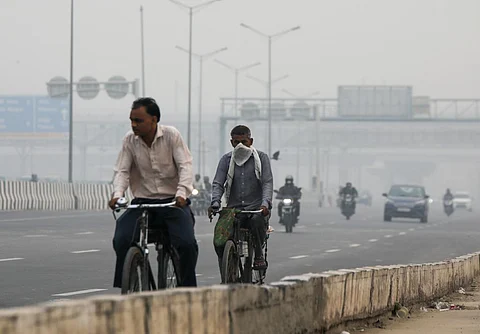

Delhi’s air quality has become a recurring concern, especially as the winter months set in, bringing with them an increasing sense of dread about the smog that blankets the capital. This year is no different and the worsening air quality is again making headlines.
While stubble burning in nearby states has long been blamed for the seasonal spike in pollution, the reality is far more complex. Local sources within the city, particularly vehicular emissions, play an equally significant— if not greater — role in Delhi’s air pollution. To effectively combat this crisis, solutions must address both regional and local contributors.
Delhi’s annual average PM2.5 concentration in 2023 was an alarming 101 micrograms per cubic metre (µg / m³), far exceeding the national standard of 40 µg/m³. While this marks a 7 per cent improvement from 2019, there’s still a long way to go before the city can meet acceptable air quality standards.
In fact, Delhi needs to reduce its PM2.5 levels by 61 per cent to achieve the national target. The past few weeks have seen a worsening trend, with PM2.5 levels rising sharply ahead of Diwali. Between October 16 and October 22, 2024, the PM2.5 average surged from 104 µg / m³ to a concerning 168 µg / m³.
Daily mean of PM2.5 concentration in Delhi (September 15–October 21, 2024)
Certain areas in the city, such as Wazirpur and Rohini, recorded even higher levels, with PM2.5 concentrations exceeding 200 µg / m³. This alarming rise in pollution underscored the urgency of the situation.
Between September 15 and October 21, 2024, Delhi experienced six "very poor" air quality days, compared to just three during the same period in 2023. As winter sets in, with its cold temperatures and stagnant air, these numbers are expected to rise further, highlighting the severity of the pollution crisis.
For years, stubble burning in neighbouring states like Punjab, Haryana and Uttar Pradesh has been a major focus of the debate surrounding Delhi’s air quality. While it contributes to the pollution levels, the share of stubble burning in the current crisis has declined.
NASA’s Visible Infrared Imaging Radiometer Suite (VIIRS) data indicated a 51 per cent drop in the total number of farm fires between 2018 and mid-October 2024. In Punjab, the largest contributor, the number of farm fires has reduced significantly from its peak in 2020.
This year, between October 12 and October 21, on average stubble burning accounted for only 0.92 per cent of the PM2.5 levels in Delhi, an analysis of the data shared by the Indian Institute of Tropical Meteorology (IITM) showed. This indicated that while farm fires still play a role, they are no longer the dominant factor.
So, if not stubble burning alone, what else is making Delhi’s air unbreathable? The answer lies within the city itself. A closer look at the sources of pollution revealed that local contributors, especially the transport sector, are responsible for a significant portion of the particulate matter polluting Delhi's air.
Data from October 12 to 21, 2024 indicated that over half of the city's PM2.5 pollution comes from vehicles. Delhi's roads are choked with over a million registered vehicles and this number continues to grow each year.
The city’s public transport system, though extensive, has not kept pace with the expanding population and economic activity, leading to an increased reliance on private vehicles, which worsens the city’s air quality.
This is compounded by other local sources, including construction dust, industrial emissions, and the open burning of waste, which further contribute to the city’s high PM2.5 concentrations.
These factors, especially during the colder months when pollutants remain trapped closer to the ground, contribute heavily to the toxic air that residents are forced to breathe.
Further, regional contributors such as industries and vehicles from neighbouring states like Haryana and Uttar Pradesh play a substantial role, as wind patterns transport pollutants into Delhi. This trans-boundary pollution adds an additional layer of complexity to an already challenging problem.
Delhi’s air pollution requires both local and regional solutions. Tackling individual issues like stubble burning or placing the burden solely on neighbouring states won’t be enough. A multi-pronged approach is necessary, focusing on key contributors such as vehicular, industrial and waste-related emissions.
To reduce vehicle emissions, Delhi must accelerate its shift towards electric vehicles and expand public transportation. Measures like better traffic management, carpooling incentives and congestion pricing can also lower emissions. Stricter controls on construction dust and cleaner industrial practices are essential, while bans on open waste burning need better enforcement alongside improved waste management systems.
Regional cooperation with Haryana, Uttar Pradesh and Punjab is crucial, as cross-border pollution impacts Delhi’s air quality. A co-ordinated air pollution management plan across the NCR, combined with local interventions like cleaner transportation and better construction practices, can be beneficial.
Delhi, as the capital, must lead by example, but sustainable improvements will require joint efforts across sectors and states.